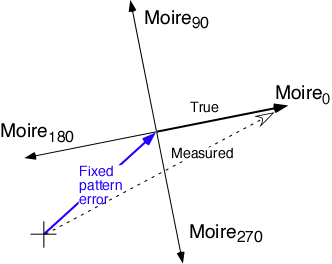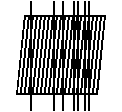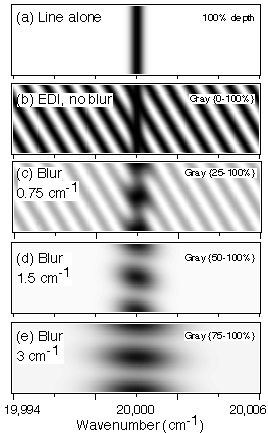|
because the multiplicative interaction between the interferometer transmission function and the stellar spectrum can be thought of as occuring prior to, or independent of, the blurring. It can be shown that the EDI Doppler signal strength varies more slowly versus R (for a fixed bandwidth) as the conventional, as R to the 1/2 power for low R instead of R to the 3/2 power. Hence for low R, the EDI has a dramatic advantage.
|
|
|
|

Moire phases for starlight and a spectral reference (iodine) can be represented by two vectors (red & green ink). Minor drift in interferometer delay with temperature, between solid and dashed, does not affect measured Doppler velocity, because it affects both the stellar and reference spectrum (iodine) fringes by the same amount. Therefore it sufficient to stabilize interferometer only to ~ /4, which is easy. Drifts of larger than /4, which is easy. Drifts of larger than  /4 during a time exposure only affect the measurement through a decrease in the average fringe visibility. /4 during a time exposure only affect the measurement through a decrease in the average fringe visibility.
|
|
|
|
The EDI is a differential technique robust to apparatus distortions
The EDI is robust to apparatus wavelength distortions that threaten the Doppler velocity stability of conventional spectrographs. This is because the interferometer comb is embedded with the stellar spectrum, so they are shifted together the same amount by aberrations in spectrograph optics, thermomechanical drifts in the CCD, air convection etc. The interferometer comb can be thought of as a grid of evenly spaced wavelength fiducials that fills the entire bandwidth.
Secondly, the phase stepping used with EDI eliminates fixed pattern errors, such as irregular gain of CCD pixels, by using only the component of the spectrum that varies synchronously with phase stepping applied to the interferometer through the PZT mirror. Conventional spectroscopy has difficulty removing these types of errors to the precision needed for Doppler velocimetry, because they are done in separate "flatfield" exposures a long time before or after the data exposures, not in real-time using the Doppler data itself.
The 2nd interferometer arm is used too
The interferometer has two outputs that are out of phase by 180 degrees, so that the sum of the outputs equals the input, and whenever there is a dark fringe in one output there is a bright fringe in the other. Our protype EDI's have ignored the 2nd output for expediency. However, our future designs for mature EDI instruments use both outputs [example] so that none of the photons are wasted (except for ordinary losses on mirror coatings and lens glass/air interfaces, which is minor). The second interferometer output would be directed to a different spot on the same CCD.
Elegant vector math simplifies analysis
We have developed elegant vector mathematics for easily determining the phase of the stellar moire pattern from the phase of the iodine reference pattern, even though they are embedded in the same signal. This is a quick and direct calculation using dot products, and is rapid even on laptop computers.
The moire pattern is represented as a vector spectrum. That is, each wavelength channel is a vector and the vector's magnitude and angle represents the fringe visibility and phase. This vector spectrum is conveniently represented by a complex wave. The beauty of this is that all popular math software packages have standard mathematical functions written for complex quantities, such as addition, subtraction, multiplication, and Fourier transforms.
|
|
|
|

The great advantage of phase stepping during data taking is that it eliminates a whole class of significant instrumental errors called fixed-pattern-errors, which can cause large velocity offset errors. The measured moire pattern (represented by a vector) is a sum of an unknown fixed pattern error plus the "good" signal. The "bad" signal is easily obtained by summing the four measured signals, taken with phase steps of 0, 90, 180 and 270 degrees. Conversely, the good signal is easily obtained by summing the four measured signals after first rotating by 0, -90, -180, and -270 degrees. This phase-stepping can be thought of as a kind of "flat-fielding" that is done in real time with the actual data. In contrast in a conventional spectrograph, the flat fielding is done in separate exposures long before or after the Doppler measurement, allowing unknown drifts to creep in.
|
|








